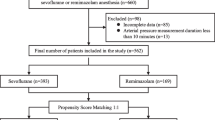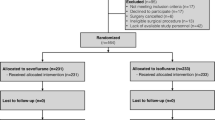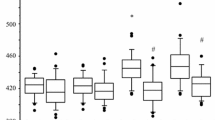Abstract
This study compared the efficacy of isoflurane, sevoflurane, and desflurane in achieving hemodynamic stability in spinal procedures using moderate levels of controlled hypotension. After obtaining ethics committee approval and written informed consent, 32 American Surgical Association I-II patients were randomly allocated to receive isoflurane (n=12), sevoflurane (n=10), or desflurane (n=10) in O2-N2O (1:1) for maintenance of anesthesia. The induction of anesthesia, fentanyl dosage, and initial and maintenance volume replacements were standardized. Blood pressure was invasively monitored and maintained within a target systolic blood pressure (SBP) range of 80 to 90 mm Hg during the study. SBP outside this range was recorded. Volatile anesthetic concentration was adjusted according to the same protocol for all 3 agents. SPB control was maintained better with sevoflurane and isoflurane than desflurane; median SBP was outside the target range during 32% (range, 15%-55%) of study time with isoflurane, 26% (12%-42%) with sevoflurane, and 44% (20%-80%) with desflurane. Total blood loss did not differ among the groups. Sevoflurane and isoflurane administered in 2 L/min fresh gas flow were more effective than desflurane in achieving controlled hypotension in spinal surgery.
Similar content being viewed by others
References
Van Aken H, Miller DE. Deliberate hypotension. In: Miller RD, ed.Anesthesia. 5th ed. New York, NY: Churchill Livingstone; 2000:1470–1490.
Bedford RF. Anesthesia for neurosurgery. In: Morgan GE et al, eds.Clinical Anesthesiology. 3rd ed. New York, NY: McGraw-Hill; 2002:567–582.
Morgan GE, Mikhail MS, Murray MJ, Larson MJ Jr. Anesthesia for orthopedic surgery. In: Morgan GE et al, eds.Clinical Anesthesiology. 3rd ed. New York, NY: McGraw-Hill; 2002:782–790.
Miura Y, Amagasa S. Perioperative cerebral ischemia and the possibility of neuroprotection by inhalational anesthetics.Masui. 2003;52:116–127.
Obal D, Scharbatke H, Barthel H, et al. Cardioprotection against reperfusion injury is maximal with only two minutes of sevoflurane administration in rats.Can J Anaesth. 2003;50:940–945.
Williams-Russo P, Sharrock NE, Mattis S, et al. Randomized trial of hypotensive epidural anesthesia in older adults.Anesthesiology. 1999;91:926–935.
Lustik JS, Papadakos PJ, Jackman K, et al. Nicardipine versus nitroprusside for deliberate hypotension during idiopathic scoliosis repair.J Clin Anesth. 2004;16:25–33.
Zellin G, Rasmusson L, Palsson J, Kahnberg KE. Evaluation of hemorrhage depressors on blood loss during orthognatic surgery: a retrospective study.J Oral Maxillofac Surg. 2004;62:662–666.
Fromme GA, MacKenzie RA, Gould AB Jr, et al. Controlled hypotension for orthognatic surgery.Anesth Analg. 1986;65:683–686.
Weiskopf RB, Moore MA, Eger EI II, et al. Rapid increase in desflurane concentration is associated with greater transient cardiovascular stimulation than with rapid increase in isoflurane concentration in humans.Anesthesiology. 1994;80:1035–1045.
Ghouri AF, White PF. Effect of fentanyl and nitrous oxide on the desflurane anesthetic requirement.Anesth Analg. 1991;72:377–381.
Beaussier M, Paugam C, Deriaz H, et al. Hemodynamic stability during moderate hypotensive anesthesia for spinal surgery. A comparison between desflurane and isoflurane.Acta Anaesthesiol Scand. 2000;44:1154–1159.
Frink EJ Jr, Malan PT, Atlas M, Dominguez LM, DiNardo JA, Brown BR Jr. Clinical comparison of sevoflurane and isoflurane in healthy patients.Anesth Analg. 1992;74:241–245.
Author information
Authors and Affiliations
Rights and permissions
About this article
Cite this article
Kurt, F., Derbent, A., Demirag, K. et al. Old method, new drugs: Comparison of the efficacy of sevoflurane, isoflurane, and desflurane in achieving controlled hypotension in spinal surgery. Adv Therapy 22, 234–240 (2005). https://doi.org/10.1007/BF02849932
Issue Date:
DOI: https://doi.org/10.1007/BF02849932




